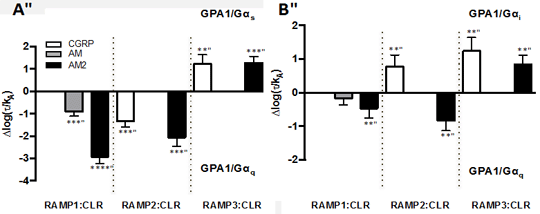Investigating G protein signaling bias at the calcitonin receptor-like receptor.
The calcitonin gene-related peptide (CGRP) family of G protein-coupled receptors responds to CGRP, adrenomedullin (AM) and adrenomedullin 2 (AM2), resulting in Gs and Gimediated signalling [1].Heterodimerization between the calcitonin receptor-like receptor (CLR) and receptor activity-modifying proteins (RAMPs) 1, 2 or 3, form the CGRP,AM1 or AM2 receptors respectively [2]. Here we identify a Gq component to CLR signaling, as well as ligand-engendered bias between Gs, Gi and Gq. We expressed RAMP:CLR complexes in yeast cells, expressing chimeric yeast/human G alpha subunits [3]. Strains expressing GPA1/Gs,Gior Gq were stimulated with CGRP, AM and AM2 (from 10-6M to 10-11 M), measuring cell growth in order to pharmacologically characterise the responses at each G protein. All three ligands were capable of inducing GPA1/Gq mediated responses at all receptors. In CGRPR expressing cells AM was a full agonist while CGRP and AM2 were partial agonists, with a rank order of ligand potency; AM2> CGRP=AM (pEC50: AM2 =8.3 ±0.3, CGRP = 7.5 ±0.2, AM = 7.5 ±0.3). At the AM1R all three ligands displayed equal maximal levels of signalling and were equipotent (pEC50:CGRP = 6.7 ±0.3, AM = 7.2 ±0.2, AM2 = 7.5 ±0.3). At the AM2R, AM was again a full agonist compared to CGRP and AM2, with an order of potency; AM > AM2 > CGRP (pEC50:AM = 7.5 ±0.3, AM2 = 6.4 ±0.3, CGRP = 5.2 ±0.4). These Gq-mediated responses differ those observed through Gs and Gi [1]. We compared the relative bias of all ligands at the receptorsby calculating Δlog(τ/kA) values [4], relative to their cognate ligands (CGRP for the CGRPR, AM for the AM1R and AM2R) (Figure 1). At the CGRPR, AM and AM2 exhibited a clear GPA1/Gq bias. Similarly, both CGRP and AM2 had a GPA1/Gq bias at the AM1R. In contrast all ligands preferentially signalled via GPA1/Gs in the presence of RAMP3. Comparison between GPA1/Gq and GPA1/Gi revealed that AM2 exhibits GPA1/Gq bias at both the CGRP and AM1 receptors. CGRP exhibits GPA1/Gi bias at the AM1R and AM2R along with AM2. This is the first characterization of a Gq bias in CLR signalling. This is currently being validated in mammalian cell lines.
Figure 1. Relative bias plots for S. cerevisiae expressing RAMPs 1, 2 or 3 and the CLR. Relative bias calculated as ∆log(T/KA), relative to the cognate ligand for each receptor (CGRP for RAMP1:CLR, and AM for RAMP2 and 3:CLR). A – GPA1/Gαsvs GPA1/Gαq. B – GPA1/Gαivs GPA1/Gαq. Statistical significance (* = p<0.05, ** = p<0.01, *** = p<0.001, **** = p<0.0001) was calculated using a one way ANOVA with a Bonferonni’s correction, data are the mean ± SEM, of 6 individual data sets.
[1] Westonet al., (2013) Proc Brit PharmacoSoc at Pharmaco. Soc. http://bps.conference-services.net/resources/344/3654/pdf/PHARM13_0058.pdf; [2]Poyneret al., (2002) Pharma. Rev. 54: 233 [3] Brown et al., (2000) Yeast 16: 11; [4]Figueroaet al., (2009) J. Pharmacol. Exp. Ther. 329: 331. Work funded by the BBSRC (G.L - BB/M00015X/1, D.P - BB/M000176/1) and MRC(I.W - MR/J003964/1)
|



